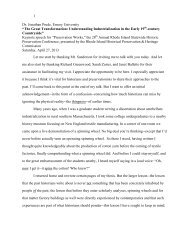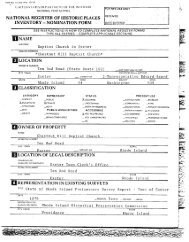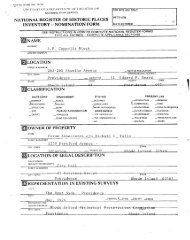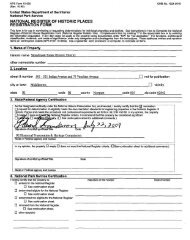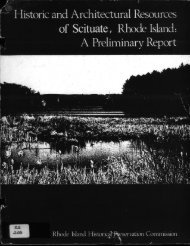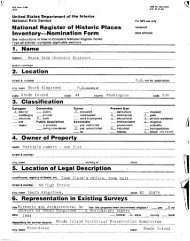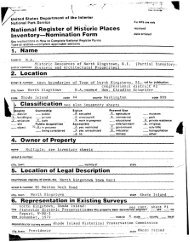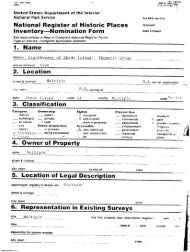National Register of Historic Places - Rhode Island Historical ...
National Register of Historic Places - Rhode Island Historical ...
National Register of Historic Places - Rhode Island Historical ...
Create successful ePaper yourself
Turn your PDF publications into a flip-book with our unique Google optimized e-Paper software.
8. Significance -<br />
- --<br />
Period Areas <strong>of</strong> Significance--Check and juslify below -<br />
prehistoric - archeology-prehistoric X community planning nandscape architecture religion<br />
1400-1499 archeonogy-historic conservation law science<br />
1500-i 599 agriculture economics literature sculpture<br />
- - 1600-1699 architecture education military x social;<br />
X 1700-1799 art engineering - music humanitarian<br />
X - 1800-1899 - - commerce exploration-settlement philosophy - - theater<br />
X 1900- communications industry politics government transportation<br />
invention - - other specity<br />
Specific dates -- - BuilderArchitect<br />
Statement <strong>of</strong> Significance in one paragraph<br />
Watch Hill is significant as a well preserved example <strong>of</strong> a late nine<br />
teenth- and early - twentieth -century summer resort, reflecting the popula ri -<br />
zation <strong>of</strong> vacations<br />
dustrial life. The<br />
during<br />
village<br />
that period as an-aspect <strong>of</strong> modern urban in<br />
is a manifestation <strong>of</strong> modes <strong>of</strong> socialization<br />
and concepts <strong>of</strong> leisure, recreation, and even health care that evolved in<br />
the Victorian era - The buildings in the Watch Hill <strong>Historic</strong> District dt’cu<br />
ment the area’s transformation from an agrarian community to a summer re<br />
sort. They are notable for- their degree <strong>of</strong> visual unity and compatibility<br />
and their skillful integration into the landscape. Certain sections <strong>of</strong> the<br />
village, laid out in the picturesque, fluid manner first adopted for the<br />
design <strong>of</strong> rural cemeteries and suburbs, stand as a good example <strong>of</strong> one type<br />
- <strong>of</strong> nineteenth-century community planning. Watch Hill joins Newport and<br />
Narragansett as the three chief exemplars in <strong>Rhode</strong> island <strong>of</strong> the summer -<br />
resort movement. Narragansett, though larger than Watch liii I, is less in<br />
tact, with much <strong>of</strong> its historical fabric destroyed hy fires, storms, and<br />
urban renewal. Among <strong>Rhode</strong> <strong>Island</strong> summer resorts today, Watch Hill is<br />
second only to Newport in its environmental character and the. ar chi tectinral<br />
qual ity <strong>of</strong> its constituent buildings.<br />
The strategic importance <strong>of</strong> the Watch Hill region was recognized I :om<br />
an early date. The Niantic indians reputedly used the area as a lookout<br />
in the early seventeenth century, to watch for attack parties <strong>of</strong> Montanip’<br />
Indjans - In the 1740s a watch post was established on the highest knoll<br />
here by the colony <strong>of</strong> <strong>Rhode</strong> Tsland during King George’s War. These activi<br />
ties are memorialized today in the name <strong>of</strong> the community.<br />
The first European settlement at Watch Hill came in the i660s, when<br />
present-day Washington County, <strong>Rhode</strong> <strong>Island</strong>, was known as the King’s Province -<br />
a territory claimed by <strong>Rhode</strong> ls-land, Massachusetts, and Connecticut. lii<br />
1662 the Massachusetts Bay Colony granted 500 acres on the easterly side<br />
<strong>of</strong> the Pequot Pawcatuck River to Captain Daniel Gooki.n , encompassing the<br />
Watch Hill peninsula. Captain Gookin erected a dwelling on the property for<br />
a tenant -farmer. Through the late seventeenth and eighteenth century, the<br />
property changed hands and was eventually subdivided. For the nest part,<br />
however, it remained in large tracts owned by only a few families - Among<br />
the early landholders were the Hannah and the Pendleton families. By the<br />
late eighteenth century, the area southwesterly <strong>of</strong> the Syndicate Line see<br />
district map and definition below had been divided into twelve lots, con<br />
sol idated in the possession <strong>of</strong> the Poster and Willcox families. Two eigh<br />
teenth-century censuses list three heads <strong>of</strong> households residing at Watch<br />
Hill: Jonathan Foster, Jonathan Foster, Jr., and Hezekiah Willcox in 1774;<br />
See Continuation Sheet #55







